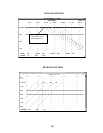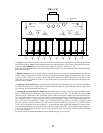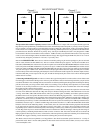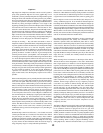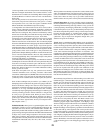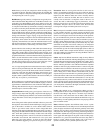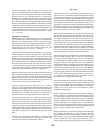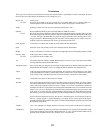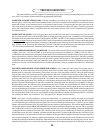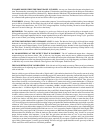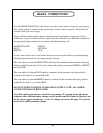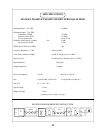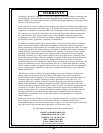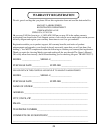If you are attempting to master the project or “pre-master” (this
year’s hot, new audio buzzword) yourself, here are some suggestions.
Take a week off after mixing, then listen to the mixes on as many
different systems as you can, friend’s homes, cars, boom boxes,
headphones, etc. and make notes. With an eye on those notes, adjust.
Now check it out on some of those systems again, before you send
it out. 80% of mastering is ensuring quality and confidence through
expertise, 20% is knob turning and then it is “which knobs, how little
(as opposed to much) and when”. On the other hand, it is only two
tracks and probably you only intend to do a minor touch-up and you
are sure it will help. It may not be as good as it gets but it is a valid
improvement and you are not doing anything radical or stupid,
so..........go for it!
Miscellaneous Techniques:
Rather than stress out trying to make one EQ solve every problem,
try a combination of two different EQs or one for recording and a
different one in mixing that track. It's like an old engineer’s trick.
Rather than look suspect with an EQ boosted 12 dB, he would use
three different EQs, each with 4 dB. It looked way better, very “pro”
and seriously into gear. Ever have producer looking over your
shoulder, checking out your "curves"?.... Nuff said.
Also it is worth experimenting with the order of processors especially
when compression, limiting and clipping is involved. We get asked
whether it is best to EQ then compress or the other way around.
People do it both ways and each has advantages depending on the
situation. If you compress first, then you should be able to boost EQ
more without clipping. If you compress after EQ, then you smooth
the track based on the new tone, which may be more leveled or
“even” sounding . De-essing, if needed, is best and easiest as a final
or next to final stage. Limiting should be the last step and should be
done gently (a few dB) because more rarely sounds better.
EQing a sub-group saves using a lot of EQ on individual tracks and
tends to blend and mesh the tracks into a cohesive group and usually
makes it easier to mix them. Lots of us group, EQ and compress the
drums or backing vocals. You should start off with the group EQ,
then the individual channel EQs should fall into place easier. Of
course, your console needs to be capable of this.
And for the opposite approach....Some guys “split” a track (or
“mult” it or copy it) and EQ one channel lightly and one heavily, then
mix them. The advantage is that you can easily change the tone by
changing the mix in automation. It also gives twice as many options
for adding reverbs and delays now that there are two channels but
expect the fader moves to affect the effect sends and balances.
You probably thought of this one - Chaining one channel of the
Massive Passive into the next one so that you have 8 bands. Here is
the cool trick - put a distortion device in that chain between the EQs.
This way you have incredible control of the distortion character. For
example, you can boost highs before the distortion, which tends to
reduce out the tendency to mostly distort the low mids, then remove
some highs after the distortion which removes some of the buzzy
edge. This is leaning towards simulating analog tape and guitar
amps.....
The first, last and only real rule about EQ is “if it sounds good, do
it”. Feel free to experiment. Enjoy and please let us know what
adventures you are having with the Massive Passive.
The Circuit
The Massive Passive is a not a particularly complicated circuit. The
audio comes in, is converted from balanced to unbalanced and DC
servo'd and given enough power (a few watts) to drive the EQ (and
output in "bypass") on the two vertical boards that the 1/4" jacks are
mounted on. It uses a BB OPA2604 op-amp and a complementary
pair of medium current transistors richly biased into near class A
operation for this. These two boards also hold the output transformers
and loading networks as well as the bypass relays. The transformer
has a tertiary feedback winding which doubles as the -10dBv output
which sort of explains why it is out-of phase.
The buffered signal is fed to the "buss boards" that connect all of the
EQ cards. The signal is first applied to the "dB" pots used for boost.
The "dB' pots on each EQ board are 10K dual reverse log and used
as a parallel voltage divider so that a boost is actually just less cut.
From here it goes to the filters and then to the main tube board for
about 25 dB of make-up gain. Then back to the buss board which in
turn feeds the "cut" sections then the front panel "gain" pots. From
here another stage of make-up gain and out through big "Multi-Cap"
capacitors to the ouputs. The boost and cut sections are separated
this way so that similar impedances can be created which allows the
same EQ components to be used for the same frequencies.
Almost all of the parts on each EQ board are capacitors and inductors
used for frequency shaping. The 11 position two deck Greyhill
switches just select the combinations of C's & L's. Closest to the
front is shelf selection. The only slightly complex part is the around
the toggle switches. In "bell mode" they have to switch each EQ
section from the boost circuit into the cut circuit. In "shelf mode" the
components for shelf get switched and the bell components get
switched into the opposite section. It uses a relay for this. The same
circuit that controls the relays also powers the boost/cut LEDs.
Lastly, the toggle switches also restrict the widest bells in bell mode
so that at least 6 dB of EQ is available, and allow a few little tricks
to voice the two lowest and highest shelves. "Bandwidth" control is
just variable series resistance, just like a Pultec.
The two tube amplifiers (per channel) are 3 triode circuits which use
one half of a 5751 for voltage gain and direct coupled into a 6414
totem-pole for current gain. The first amplifier uses less than 6 dB
of plate to grid feedback. The second amplifier uses the tertiary
winding via a trim pot back to the 5751 cathodes for variable
feedback and final gain trim.
The power supply provides about 350 VDC for the tubes. The multi
section "pi filtering" is on the tube board and is held pretty constant
by 3 zener diodes. The supply also gives two 12V medium current
outputs for the tube filaments, LEDs and relays. The two regulators
mounted on the back panel are for these 12V supplies. There is also
a positive and negative 18V regulated supply for the input circuit
which is also sent to the buss board for future purposes. Lastly the
power-on muting is done with a 555 on the power supply board. It
feeds the "bypass" switches which feed the relays.
The only potential tricky part of tracing the signal is due to the signal
levels changing (dropping 20 to 25 dB) a few times and being
restored a few times. The good news is that, for all the parts in the
Massive Passive, there is only a small number in the signal path and
mostly in parallel. Over 95% of the repairs should only involve
replacing a tube and verifying the gain is unity or needs a little trim.
24



